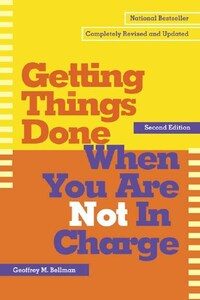You are not in charge. You may not be clear who is in charge, but you know that you are not. In spite of this, you want to do your work well, you want to contribute to the organization, and you want to succeed personally. These wants often cause conflict, as you are challenged to support others’ goals while working toward your own. You feel irritated by the difficulty of trying to get something done and not having the power to do it. You feel constrained by the formal and informal boundaries of the organization. You try to do your best, but keep running up against the rules of play in the organization you are trying to help. You may work in the profit or not-for-profit sector. You may give your time or work for money. You may be a manager, a director, a salaried or an hourly worker. It does not matter. You share with many others the desire to do good work, the need for recognition, and the frustration of having your efforts blocked by the very organization you are trying to serve.
You are not as powerless as you sometimes feel: that is the main premise of this book. This book explores the many ways you can get things done, support the work of others, and find greater life fulfillment through your work. There are ways of dealing with the issues inherent in working for an organization. I know the issues well after thirty-five years in and around organizations. I have lived with the dilemmas of working from the middle of large corporations, government agencies, school systems, hospitals, foundations, and not-for-profit organizations. I have had amazing success and sobering failure, and I have learned. This book builds on my learning, and on the learning of others with whom I have worked, and it can be a guide to your learning as well. It is my answer to the question “How can you feel good about your work and make a difference when you have little formal power?”
Organizations loom large in our lives; you know the struggles that come with working in them. You know what it is like to have clear, constructive intentions and to be confounded by the way this place works. You know how hard it is to hold onto hope while faced with daily frustrations. You know the stress, the burnout, the fatigue, and you have felt yourself alternately rising to the challenge or sinking into skepticism. You see those frequent “learning opportunities” that come with trying to get something done, and sometimes feel that you have learned enough – it is somebody else’s turn. You know the energy it takes to step back into the fray, and are tempted just to save your energy and protect yourself. This book helps your pursuit of the hope, the challenge, the opportunity, and the learning from right where you are now, in your formally less-powerful position.
“I am not in charge.” Can you hear yourself saying these words? Say them aloud or in your mind: What do you sound like? What was your tone of voice? How did you feel? When did you last say something like this to someone about your work? As I have listened to myself and others say these words, I sort the statements and their underlying feelings into two stacks: One stack sounds more active, hopeful, or even matter-of-fact; the other sounds more passive, powerless, or even victimized. Over my many work years, I have contributed to both stacks… and guess which stack I feel better about.
If you are not in charge, who is? That is a good question. You will see, as you read further, that I doubt any one person is truly in charge. We create a sense of purpose and responsibility together, and we do it in ways that make us all interdependent – whether we choose to see it that way or not. Everyone is accountable to others, and that accountability circles back within the boundaries of an organization, helping to define what it is and what it does. We point to the CEO’s or ED’s or Chairs as if they are in charge, but that is more our wish for simplicity and security than it is an expression of reality. We maintain the “inchargeness” that selected people experience for organizational convenience; we know just how much and how little they are really in charge of. We agree to putting some people “in charge,” knowing that they have to earn the support of the people around them if they are to get anything done.
If anyone is in charge around here, it is the top executive, right? Well, no. In my close work with the leaders of many organizations, I have noticed the direct relationship between their effectiveness and not being in charge. Said differently, those executives who constantly be-have as if they are in charge are not nearly as effective as those who act as if they are not.
What This New Edition Is About
Fifteen years ago, I wrote what I thought was my first and last book on getting things done from the middle of large organizations. That book was titled The Quest for Staff Leadership; it was written for the managers of service and support functions in corporate America. The book was well received, went through five printings, and even received a national award. Six years later I revised the book significantly, wrote it to a wider audience – everyone in support positions in the corporate world. And here I am rewriting it yet again, and reaching out beyond the corporate world to everyone in the middle of organizations of any kind. This rewriting, moving from book two to book three, is just as significant as the move from book one to book two. There are two main reasons: what has been happening in the organization world and what I have learned along the way.








